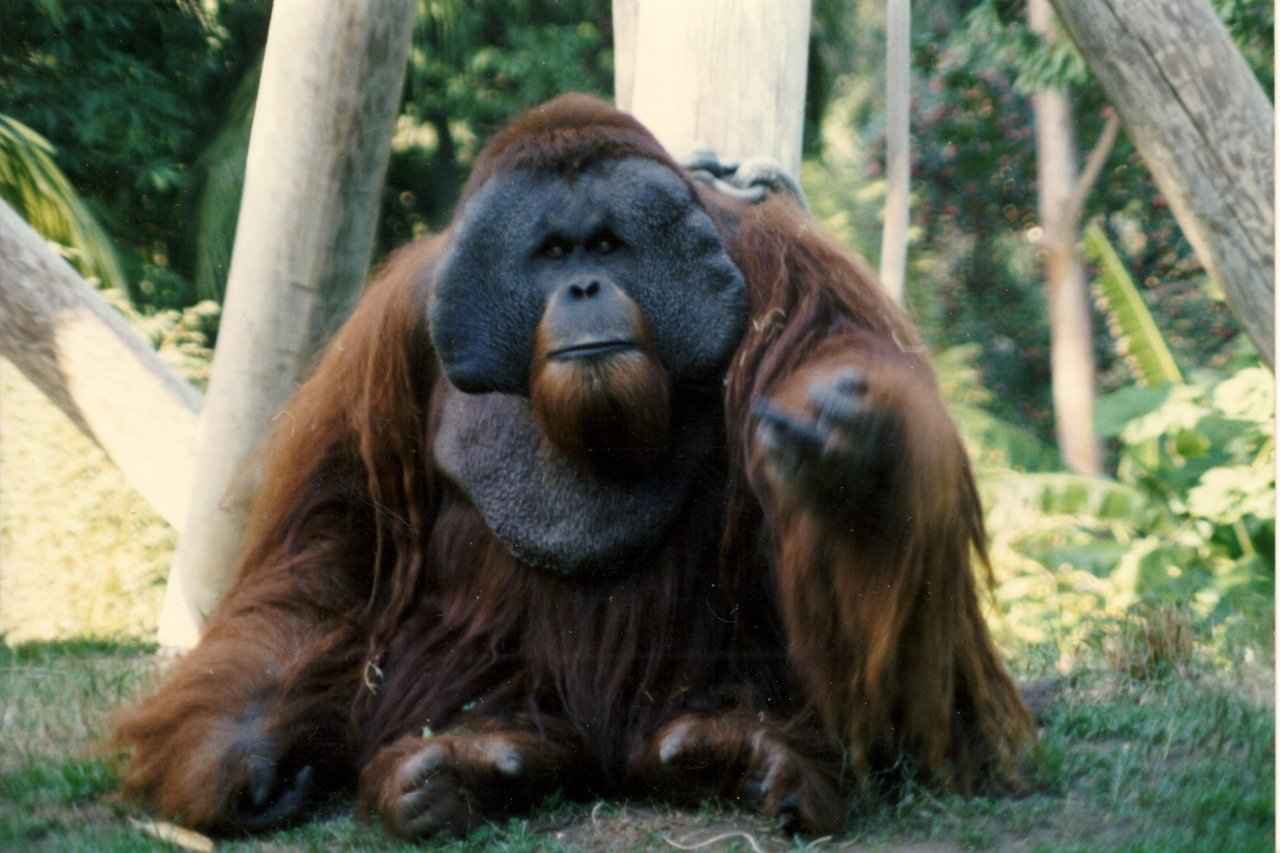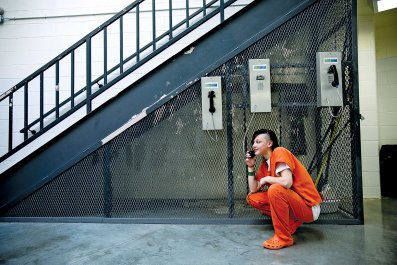It's hard to be an ape in 2016. In the wild, their habitats are encroached upon by deforestation and pollution and poaching. And things are just as bad in zoos. Last month, headlines mourned the death of Harambe, the gorilla at the Cincinnati Zoo shot to death when he started dragging around a 3-year-old boy who had fallen into his enclosure.
It wasn't always this difficult. On June 13, 1985, a 250-pound orangutan named Ken Allen climbed up his retaining wall at the San Diego Zoo and escaped his exhibit. He walked down a public path toward crowds of weekday tourists, stopping to look at the other animals as if he were a visitor before being led back to his cage. It would not be the last time the ape escaped, but instead of a PR disaster, for a brief time in San Diego, Ken Allen became a folk hero.
After that first escape, zoo officials ramped up security in his pen—an open area with a jungle gym made of utility poles and a large moat in the back. Behind the moat was a massive wall, which they extended 4 feet—but it wasn't enough to contain Ken Allen.
A few weeks later, in July, he managed to climb the wall again. This time, he was a bit more irritable. Zookeepers found him in front of another ape enclosure, tossing rocks at Otis, a fellow orangutan and former pen-mate who, according to the Los Angeles Times, was "not known to be amiable."
The escapes continued. That August, Ken Allen found a crowbar in his pen that workers had left behind. He tossed it to another orangutan, Vicki, who used it to pry open a window and let Ken out. After that incident, he was moved temporarily to an indoor pen with "a black-and-white television with one working channel," according to the Times, while zookeepers increased the security of his original exhibit.
Zookeepers probably should have seen his knack for escaping earlier. Born in captivity, Ken Allen got his name from the two zookeepers, Ken Willingham and Ben Allen, who rescued him from his also-captive mother after she attempted to smother him. As an adolescent, he would regularly unscrew the bolts of his cage and explore his nursery at night, returning in the morning and putting it back together before his keepers arrived.
Reports of the orangutan's quest for freedom—especially in the '80s, an era known for its schmaltzy patriotism—became a major selling point for the zoo. It began printing T-shirts featuring all of the headlines written about Allen and sold them for $14. "Free Ken Allen" bumper stickers were printed, and he was recently immortalized by San Diego's Monkey Paw Brewing Co. with a beer flavor named for the same slogan . One newspaper article described him as "Hairy Houdini," a nickname that stuck.
Ken Allen even had a fan club, consisting mostly of retirees who called themselves the Orang Gang. One member, a lab assistant named Twyla Baker, printed a 100-subscriber newsletter called the "The Orang Gang News."
A San Diego–based psychiatrist named Dennis Gersten (who now sports an eye patch and goes by David) was so inspired by Ken Allen that he wrote a song about him. "In 1985, a friend of mine called and said, 'Have you heard about Ken Allen?' I hadn't," Gersten says. She told him the story, and "by the time she finished...the wheels were turning. I said to her, 'I've got to go now. Thanks for calling.' I sat down, with the inspiration pumping, and wrote most of the Ken Allen song in 10 minutes."
Gersten, who tells Newsweek he has written "more than 2,200 songs in numerous genres" and "began composing symphonic works 10 years ago," hit the studio and recorded "The Ballad of Ken Allen." Sample lyrics include "Ken Allen is one hunk of a man/Never speaks too much/He has big ol' hairy hands/He's got a lifetime sentence for some monkeying around/He said no bars can hold him/Now that boy is jungle-bound."
The song became an instant local hit, and a 45 rpm single was sold at the zoo for several years. Local NBC affiliate KNSD invited Gersten to play the song on TV.
Meanwhile, zookeepers struggled to contain Ken Allen. They surrounded the moat's wall with electric wire and hired rock climbers to look for potential escape routes. Once the orangutan learned not to try anything around uniformed zoo employees, they went undercover, disguising themselves as tourists—what one headline dubbed "gorilla tactics."
Eventually, the zoo spies caught him climbing "like Spiderman" up the exterior wall, before brushing the electric wire and giving up. The new security measures seemed to work. According to one report, Ken Allen "settled down as a 'family man.'"
But that was only a ruse. Two years later, he escaped again. This time, his enclosure's water pump clogged, causing the moat to dry up. Before anyone noticed, according to a Los Angeles Times article, he "walked across the dry moat and hoisted himself onto rocks outside the enclosure."
Once again, he wandered around the zoo, posing for photos with tourists. A zoo gardener spotted him and cleared the area. As security guards converged on him, guns ready, Ken Allen bolted, heading toward the lion pens. Before he reached them, veterinarians managed to corral him back to his enclosure, "nervous and agitated," but unharmed. It was the farthest from his enclosure he'd ever gotten.
Desperate, zookeepers added female orangutans to his pen, thinking they could distract him. "We thought maybe he was jealous of Otis's three female friends," zoo spokesman Jeff Jouett told the Times, "so we gave him four more, hoping to turn his wanderlust into just lust."
Ken Allen was a bad influence on his new friends. A few months later, two of them, Jane and Kumang, found a 5-foot-long squeegee left behind by window washers and used it to climb up the wall. Jane was found walking on the path near the flamingo exhibit and was tranquilized, while Kumang was peacefully returned to her pen.
The zoo spent roughly $45,000 on new security measures, and the escapes finally stopped. Ultimately, there were nine total breakouts, according to the Lodi News-Sentinel, "with crowds cheering the apes on as keepers ran after them."
Even for those who remember them, Ken Allen's escapes have become the stuff of urban legend. "When my dad was younger, he and his friends went to the zoo when Ken Allen got out of his enclosure. He was walking around shaking everybody's hands, looking at animals and having a good time," said YouTube user 101FallingRock in a comment. "Then he ran off when the keepers tried to put him back in his cage. But he was cool. "
The local news kept up with him for a few more years, but the coverage gradually faded, and Ken Allen returned to a simple life of sitting in his pen and giving young children the finger.
In the winter of 2000, Ken Allen began acting erratically and was diagnosed with B-cell lymphoma. "The Orang Gang News" published a special, two-page tribute edition and held a candlelit vigil for him. Retired postal employee and Orang Gang member Marlene MacLeay told the Times, "He'd have done the same for us."
With little hope of survival, Ken Allen was euthanized and cremated on December 1, 2000. He was 29. The zoo installed a memorial in his honor.
Then again, maybe that's just what they want you to think. Perhaps Ken Allen faked his death in an elaborate, final escape plan, and he's laying low across the border in Mexico. And maybe one day he'll return, if only to throw more rocks at Otis.




















